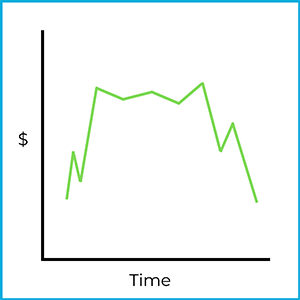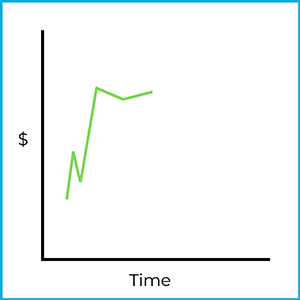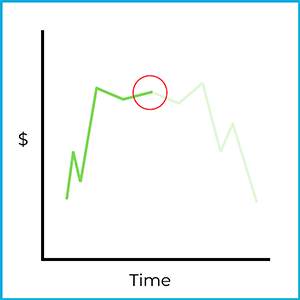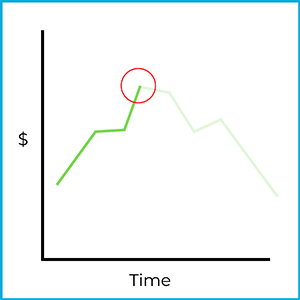In the previous chapter, you learned about fundamental analysis, which involves inspecting company finances. We’re now shifting into a different type of analysis.
Technical analysis involves identifying and predicting trends in the stock market. Technical analysts typically pay little-to-no attention to the fundamentals of a company (e.g. expenses, revenues, etc.). They’re more concerned with finding predictable stock price patterns and betting on those patterns occurring again.
Technical analysts believe history repeats itself in the market. To better understand this, let’s look at a stock chart:

While this may look like a basic stock chart, a technical analyst would identify this as a unique formation. Specifically, this is a head and shoulders bottom formation. While the stock’s market movement already played out with the chart above, it could be used to predict where the stock price goes in the future. For example, what if a few days later the same stock started fluctuating like this:

While there’s no promise the market price will move in the same direction, there is some evidence of repeating market trends in the real world. If this stock follows the same trajectory as it did previously, a purchase at this point would be profitable:

Again, the market is unpredictable and could easily go the other way. Technical analysis is a prediction tool, but not all predictions come true. It takes a fair amount of chart analysis to find these trends, which is why technical analysts are sometimes referred to as “chartists” (chart artists).
Saucer formations are market trends that include a reversal. There are two types of saucer formations: saucer bottom formations and saucer top formations.
A saucer bottom formation looks something like this:

It kind of looks like a saucer (bowl), right? Technical analysts try to identify trends like this, which help them predict future market movements. While the stock price started and ended in the same general area, the stock is moving upwards after bottoming out. This is referred to as a reverse downward trend. The stock price was moving down, then reversed back upward.
Technical analysts are on the lookout for the beginning of a saucer formation. For example:

If a chartist identified this as the beginning stage of a saucer bottom formation, they could make a quick profit by going long (buying) the stock at this point:

Of course, the market is unpredictable and could move in a different direction. However, the market does trend in a predictable fashion from time to time. A confident technical analyst making an investment would be taking a risk, but the risk could pay off.
If you were to flip the previous stock charts upside down, you’d have a saucer top formation. It looks like this:

Kind of like an upside-down saucer (bowl), right? The market was trending upward, flattened out, then reversed back downward. This is an example of a reverse upward trend. Chartists keep an eye out for the initial stages of a saucer top formation.

If properly identified as the beginning of a saucer top formation, an investor could make a quick profit by going short (short selling) the stock at this point:

Again, the market is unpredictable and could move in a different direction. A confident technical analyst making an investment would be taking a big risk (selling short comes with unlimited risk), but it could pay off. If the trend continued downward beyond this chart, the investor would make a significant profit.
Head & shoulders formations are market trends that include a reversal, like saucers. There are two types of head & shoulder formations: head & shoulders top formations and head & shoulder bottom formations.
A head and shoulders top formation looks something like this:

Hopefully, you see a basic outline of a person. A head & shoulders top formation rises, flattens, rises again, flattens again, falls, flattens one last time, and falls again. Initially, the stock price was trending upwards, but then it reversed at the top and moved back downward. This is an example of a reverse upward trend.
Technical analysts are on the lookout for the beginning of a head & shoulders formation. For example:

It may not look like much, but a skilled technical analyst may pick this out as the beginning of a head & shoulders top formation. If they are correct, they could make a return by going short (selling short) the stock:

Borrowing shares and selling them at this point could return a large profit, although the investment is subject to considerable risk. Short selling (discussed in detail in a future chapter) subjects investors to unlimited risk potential! Stock movements are never 100% predictable, but a confident chartist might pull the trigger and short the stock at this point. If the market trends in the expected direction, a large profit could be made!
A head & shoulders bottom formation is basically an upside version of a top formation:

Does it look like a person hanging upside down? A head & shoulders bottom formation falls, flattens, falls again, flattens again, rises, flattens one last time, and rises again. Initially, the stock price was trending downwards, but then it reversed at the top and moved back upward. This is an example of a reverse downward trend.
Chartists watch the market for the initial stages of head & shoulders formations:

An experienced chartist may identify this as the beginning of a head & shoulders bottom formation. If they are correct, they could make a profit by going long (buying) the stock:

Again, stock movements are never 100% predictable, but a confident technical analyst may buy a bunch of stock if they spotted this trend. If they’re right, they can make an unlimited return the further the market rises.
Fundamental and technical analysis are two different approaches to evaluating investments.
Fundamental analysis focuses on what to buy by examining a company’s financial health and economic conditions. Investors look at factors like earnings, revenue, price-to-earnings (P/E) ratio, dividends, and balance sheets to determine a stock’s intrinsic value. This method is often used by long-term investors who want to find undervalued companies with strong growth potential. For example, an investor might buy a stock because it has consistent earnings growth and a low P/E ratio compared to its industry.
Technical analysis focuses on when to buy by analyzing price trends, charts, and market patterns. It relies on predictable stock price patterns since history tends to repeat itself in the market. This method is mostly used by short-term traders but can also be used for the long term, looking to capitalize on price fluctuations. For instance, a trader might buy a stock because it has broken above a key resistance level, signaling potential upward momentum.
It’s important to understand that fundamental analysis helps determine whether a stock is a good investment based on financial data, while technical analysis is used to time market entries and exits based on trends. Many investors use both methods together for a well-rounded strategy.
Sign up for free to take 4 quiz questions on this topic